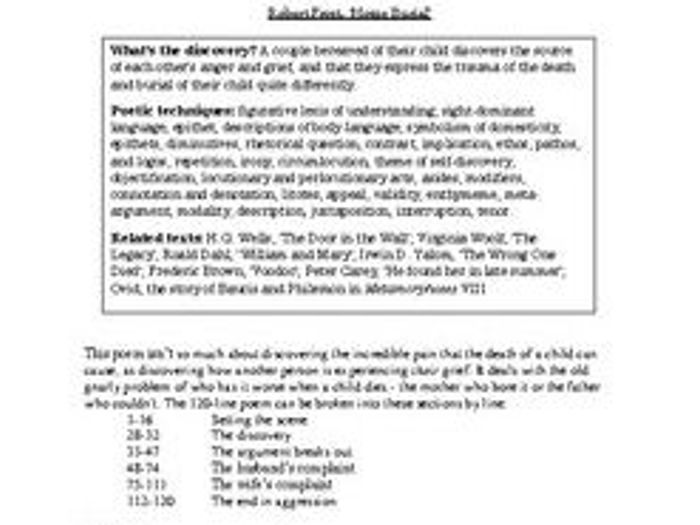

He moves in darkness as it seems to me, Not of woods only and the shade of trees. I see him there Bringing a stone grasped firmly by the top In each hand, like an old-stone savage armed. Something there is that doesn't love a wall, That wants it down.' I could say 'Elves' to him, But it's not elves exactly, and I'd rather He said it for himself. Before I built a wall I'd ask to know What I was walling in or walling out, And to whom I was like to give offense. He only says, 'Good fences make good neighbors.' Spring is the mischief in me, and I wonder If I could put a notion in his head: ' Why do they make good neighbors? Isn't it Where there are cows? But here there are no cows. My apple trees will never get across And eat the cones under his pines, I tell him. It comes to little more: There where it is we do not need the wall: He is all pine and I am apple orchard. Oh, just another kind of outdoor game, One on a side. And some are loaves and some so nearly balls We have to use a spell to make them balance: 'Stay where you are until our backs are turned!' We wear our fingers rough with handling them.

To each the boulders that have fallen to each. I let my neighbor know beyond the hill And on a day we meet to walk the line And set the wall between us once again. The gaps I mean, No one has seen them made or heard them made, But at spring mending-time we find them there. The work of hunters is another thing: I have come after them and made repair Where they have left not one stone on a stone, But they would have the rabbit out of hiding, To please the yelping dogs. The poem, by the way, recognizes that borders are problematic: the narrator says “you have to ask yourself / whom you are going to include, who to exclude, / and who can end up with an upset.” However, if you look at it with A psychological rather than a sociological lens, the idea that mending borders is a way of addressing the integrity of human relationships is certainly very sensible.Something there is that doesn't love a wall, That sends the frozen-ground-swell under it, And spills the upper boulders in the sun And makes gaps even two can pass abreast.

For the modernist sensibility, interested in the erosion of borders and in the inclusion of what had previously been excluded, the idea that attention to borders is essential to cultivate satisfactory relationships is quite conservative, especially if the emphasis falls on the borders between the social categories of the time. Mending Wall is smooth and uninterrupted (albeit unrhymed), but The Death of the. Of course, the above summary does not do justice to the narrative richness of the poem, but the essential thing, for the purpose of pointing out possible interpretations, is that there are two neighbors who meet sporadically in the dividing line of the properties and give themselves ( in a somewhat ceremonious way) to the task of mending the wall that separates them. Home Burial is not the only poem in the book to exhibit these traits. The neighbor, on two separate occasions, only responds “good wall, good neighbor” and continues with the ceremonial ritual of mending the wall. Also, there is something that is not a friend of the walls, something that is responsible for insulting them every winter. Through this poem, he has tried to explore the way people isolate themselves physically and emotionally by building barriers like fences to derive a sense of safety. This poem is the first work in Frost’s second book of poetry, North of Boston (1915). There is something that is not friend of the walls, the narrator tells us in the first line of the poem, and then the same narrator tries to persuade his neighbor of the uselessness of that ritual that brings them together: the wall would be useful if one of the neighbors I had cows, for example, but that is not the case. Mending Wall is a dramatic-narrative poem by Robert Frost, a popular American poet. In the poem, the narrator (presumably Frost himself) meets with his neighbor to mending, as every spring, the wall in the dividing line of property. Trochaic feet are in red, Spondees are purple, Anapests are blue, and Feminine Endings are green, Phyrric feet are yellowish.
#Scansion mending wall free#
At a time when the most important figures of American poetry shamelessly declared their distaste for metrics and traditional forms, Robert Frost-always on the fringe of Modernist experiments-wrote poems that his contemporaries would have called “antiquated.” to the prosodic integrity of poetry, Frost renounced the proliferation of free verse, that way “of playing tennis without using red.” The poem “mending the Wall” -the one that best captures the poetic art of Frost- makes an allusion (when compare the mending of the wall with a country game) to this metaphor. To show just how divergent the metrical usages are between the two poems, I’ve color coded the scansion of Mending Wall and Birches.


 0 kommentar(er)
0 kommentar(er)
